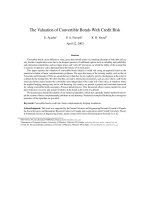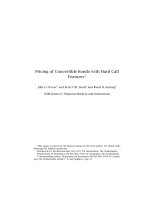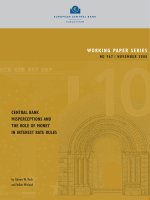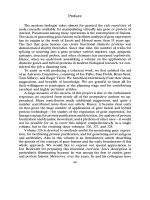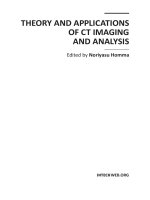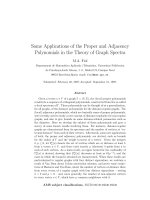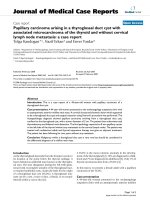Applications of malliavin calculus and white noise analysis in interest rate markets, and convertible bonds with and without symmetric informaiton
Bạn đang xem bản rút gọn của tài liệu. Xem và tải ngay bản đầy đủ của tài liệu tại đây (361.61 KB, 84 trang )
APPLICATIONS OF MALLIAVIN CALCULUS AND
WHITE NOISE ANALYSIS IN INTEREST RATE
MARKETS, AND CONVERTIBLE BONDS WITH AND
WITHOUT SYMMETRIC INFORMATION
By
Wong Man Chui
A THESIS SUBMITTED FOR THE DEGREE OF
DOCTOR OF PHILOSOPHY
DEPARTMENT OF MATHEMATICS
NATIONAL UNIVERSITY OF SINGAPORE
DEC 2007
c
Copyright by Wong Man Chui, 2007
NATIONAL UNIVERSITY OF SINGAPORE
DEPARTMENT OF
MATHEMATICS
The undersigned hereby certify that they have read and recommend
to the Faculty of Graduate Studies for acceptance a thesis entitled
“Applications of Malliavin Calculus and White Noise Analysis
in Interest Rate Markets, and Convertible Bonds with and
without Symmetric Information” by Wong Man Chui in partial
fulfillment of the requirements for the degree of Doctor of Philosophy.
Dated: Dec 2007
External Examiner:
Research Supervisor:
Dr. Lou Jiann Hua
Examing Committee:
ii
NATIONAL UNIVERSITY OF SINGAPORE
Date: Dec 2007
Author: Wong Man Chui
Title: Applications of Malliavin Calculus and White
Noise Analysis in Interest Rate Markets, and
Convertible Bonds with and without Symmetric
Information
Department: Mathematics
Degree: Ph.D. Convocation: February Year: 2009
Permission is herewith granted to National University of Singapore to
circulate and to have copied for non-commercial purposes, at its discretion, the
above title upon the request of individuals or institutions.
Signature of Author
THE AUTHOR RESERVES OTHER PUBLICATION RIGHTS, AND
NEITHER THE THESIS NOR EXTENSIVE EXTRACTS FROM IT MAY
BE PRINTED OR OTHERWISE REPRODUCED WITHOUT THE AUTHOR’S
WRITTEN PERMISSION.
THE AUTHOR ATTESTS THAT PERMISSION HAS BEEN OBTAINED
FOR THE USE OF ANY COPYRIGHTED MATERIAL APPEARING IN THIS
THESIS (OTHER THAN BRIEF EXCERPTS REQUIRING ONLY PROPER
ACKNOWLEDGEMENT IN SCHOLARLY WRITING) AND THAT ALL SUCH USE
IS CLEARLY ACKNOWLEDGED.
iii
Table of Contents
Table of Contents iv
Acknowledgements vi
Summary vii
1 The interest rate markets model framework 1
1.1 Introduction . . . . . . . . . . . . . . . . . . . . . . . . . . . . . . . . 1
1.2 Martingale Modelling . . . . . . . . . . . . . . . . . . . . . . . . . . . 3
2 Applications of Malliavin calculus to Monte Carlo methods in pric-
ing interest rate derivatives 6
2.1 Introduction . . . . . . . . . . . . . . . . . . . . . . . . . . . . . . . . 7
2.2 Preliminary Malliavin Calculus . . . . . . . . . . . . . . . . . . . . . 9
2.3 Application of Malliavin Calculus to Target Redemption Note . . . . 12
2.4 Application of Malliavin Calculus to Callable Libor Exotics . . . . . . 16
3 Applications of Fractional white noise calculus to illiquid interest
rate markets 20
3.1 Introduction . . . . . . . . . . . . . . . . . . . . . . . . . . . . . . . . 21
3.2 Preliminary Fractional White Noise Analysis . . . . . . . . . . . . . . 22
3.3 Fractional Interest Rate model . . . . . . . . . . . . . . . . . . . . . . 25
3.4 Managing Market Risk Exposure under Fractional Interest Rate Markets 27
3.5 Convexity Adjustment under Fractional Interest Rate Markets . . . . 29
4 Convertible Bonds with Symmetric Information 34
4.1 Introduction . . . . . . . . . . . . . . . . . . . . . . . . . . . . . . . . 34
4.2 Some Properties of Convertible Bonds . . . . . . . . . . . . . . . . . 36
4.3 Convertible Bonds with Counterparty Risks . . . . . . . . . . . . . . 46
iv
5 Convertible Bonds with Asymmetric Information 57
5.1 Introduction . . . . . . . . . . . . . . . . . . . . . . . . . . . . . . . . 57
5.2 No Arbitrage Opportunity Pricing with Asymmetric Information . . . 60
5.3 Pricing Convertible Bonds with Asymmetric Information . . . . . . . 65
Bibliography 73
v
Acknowledgements
I wish to express my sincere gratitude to my mentor Dr. Lou Jiann Hua for his
guidance and for his help on this thesis.
vi
Summary
The Applications of Malliavin calculus and white noise analysis in stock markets has
been well-known in the Mathematical Finance’s literature. But its application to
interest rate markets has been minimal. The aim of this work is to fill in this gap.
In recent years it has become clear that there are various applications of Malliavin
Calculus as far as the integration by parts formula is concerned. One of its successful
applications is to compute the Greeks (i.e., price sensitivities) of Financial derivatives
in stock markets. In fact, the exotic products created in interest rate markets are as
complicated as in the stock markets. Target Redemption Notes are one of the good
examples for this application due to their discontinuous payoff. In the first of this
thesis, we will provide two of its applications to the interest rate derivatives.
Fractional Brownian motion has been applied to describe the behavior to prices
of assets and volatilities in stock markets. The long range dependence self similarity
properties make this process a suitable model to describe these quantities. In interest
rate markets, we can also observe the same behavior. To model the bond prices
driven by Fractional Brownian, we apply the multi-dimensional Wick-Itˆo integral as
it precludes arbitrage opportunities. This framework is particular useful if the market
is illiquid as the trader cannot really observe the true market price and he is forced
to quote the market price when his client is asking for it. We will demonstrate how
two financial problems can be solved under this model framework in the second of
this thesis.
A convertible bond has many of the same characteristics as an ordinary bond but
vii
viii
with the additional feature that the bond may, at any time of the owner’s choosing,
be exchanged for a specified asset. Moreover, it is also common that the issuer may
have the right to terminate the contract. In other words, this contract enables both
their buyer and seller to stop it at any time. It is in fact a subset of Game Options.
In Chapter 4, we are going to look at some of the properties of this derivative. We
will also consider the case when there is default risk involved. In the final chapter,
we suggest a method how to price this derivative when there is insider information.
Chapter 1
The interest rate markets model
framework
In this chapter we review the classical HJM model which captures the full dynamics of
the entire forward rate curve, while the short-rate models only capture the dynamics
of a point on the curve [10]. The key to these techniques is the recognition that the
drifts of the no-arbitrage evolution of certain variables can be expressed as functions
of their volatilities and the correlations among themselves. In other words, no drift
estimation is needed. The importance of the HJM model lies in the fact that virtually
any (exogenous term-structure) interest-rate model can be derived within such a
framework.
1.1 Introduction
Let W be a d-dimensional standard Brownian motion given on a filtered probability
space (Ω, F, P). As usual, the filtration F = F
W
is assumed to be right continuous
and P− completed version of the natural filtration of W . D. Heath, R.A. Jarrow and
A. Morton in their paper [10] assumed that, for a fixed maturity T ∈ [0, ∞), the
1
2
instantaneous forward rate f (t, T ) evolves, under a given measure, according to the
following diffusion process:
df(t, T ) = α(t, T )dt + σ(t, T ) · dW (t), ∀t ∈ [0, T ], (1.1.1)
for a Borel-measurable function f(0, ·) : [0, T ] → R, the market instantaneous forward
curve at time t = 0, and some functions α : C x Ω → R
d
, σ : C x Ω → R
d
where
C = {(u, t)|0 ≤ u ≤ t ≤ T}. Moreover for any maturity T, α(·, T ) and σ(·, T ) follow
adapted processes, such that
T
0
|α(u, T )|du +
T
0
|σ(u, T )|
2
du < ∞, P − a.s.
A zero coupon bond of maturity T is a financial security paying to its holder one
unit of cash at a pre-specified date T in the future. The price of a zero coupon bond
of maturity T at any instant t ≤ T will be denoted by P (t, T ); it is obvious that
P (T, T ) = 1. We will usually assume that, for any fixed maturity T , the bond price
P (·, T ) follows a strictly positive and adapted process on a filtered probability space
(Ω, F, P).
Moreover we have a one to one relationship between zero-bond prices and forward
rates
f(t, T ) =
−∂ ln P (t, T )
∂T
P (t, T ) := e
−
T
t
f(t,u)du
.
(1.1.2)
One can show that in order for the dynamics in (1.1.1) arbitrage free, the function
α cannot be arbitrarily chosen and it must have the following form under the risk
neutral measure Q
α(t, T ) = σ(t, T ) ·
T
t
σ(t, s)ds (1.1.3)
3
The dynamics of f(t, T ) and P (t, T ) will then have the following forms under the
risk neutral measure,
f(t, T ) = f(0, T ) +
t
0
σ(u, T ) ·
T
u
σ(u, s)dsdu +
t
0
σ(s, T ) · dW (s)
dP (t, T ) = P (t, T )
r(t)dt −
T
t
σ(t, s)ds
· dW (t)
(1.1.4)
where r(t) is the instantaneous short term interest rate at time t, that is
r(t) := f (t, t) = f (0, t) +
t
0
σ(u, t) ·
t
u
σ(u, s)ds
du +
t
0
σ(s, t) · dW (s)
(1.1.5)
Remark 1.1.1. The dynamics, dP (t, ·), in (1.1.4) is the process which will be modified
in Chapter 3 in order to capture the long dependence property that we have observed
in interest rate markets. In this paper, we do not consider the reparametrization
method which was proposed by Musiela. [17]It tackles the issues such as non-varying
state space and non-local state dependence which exist in the HJM framework. But
it will complicate the development of our model presented in Chapter 3.
1.2 Martingale Modelling
This section introduces how interest rate derivatives can be priced under the risk
neutral measure Q in the HJM framework. The Libor Market Model will also be
introduced at the end of this section which leads us to the Greeks computation in
Chapter 2 as delta and gamma are always defined in terms of the change of derivative
price due to a unit change of the forward Libor Rate.
4
In the previous section, we mentioned that the condition (1.1.3) would guarantee
that arbitrage opportunities do not exit in the interest rate market. However, in order
to enable us to use the risk neutral method to price any interest rate derivatives, we
have to make sure that the market is complete. In fact such a risk neutral measure
Q is unique. We have the following proposition which states the conditions for the
uniqueness.
Proposition 1.2.1. The martingale measure is unique iff for each fixed t there exist
maturities T
1
, , T
d
such that the matrix D(t; T
1
, , T
d
)
i,j
:= {σ
i
(t, T
j
)} is nonsingu-
lar.
Proof. See [7]
Under the risk neutral measure, the price of an option, π
t
(X) with final payoff, X
(i.e., any F
T
measurable real-valued random variable) can now be computed as
π
t
(X) = E
Q
B
0
(t)
B
0
(T )
X
F
t
(1.2.1)
where B
0
(t) = exp
t
0
r(s)ds
is the saving account.
Next we define Forward Libor rates which can be considered as the underlying of
most of the interest rate derivative contracts.
Definition 1.2.1. The forward δ− period Libor rate for the future date T prevailing
at time t is L(t, T, T + δ)δ :=
P (t,T )
P (t,T +δ)
− 1 where δ > 0.
Proposition 1.2.2. If one defines an equivalent measure Q
T +δ
Q on (Ω, F
t
) by
dQ
T +δ
dQ
=
1
P (0,T +δ)B
0
(T +δ)
,then L(t, T, T + δ) is a Q
T +δ
martingale
5
Proof. By definition 1.2.1, L(t, T, T + δ) can be written as
(P (t,T )−P (t,T +δ))
P (t,T +δ)δ
. Since
P (t, T ) and P (t, T + δ) are both tradable and any tradable divided by the numeraire,
P (t, T + δ), is a Q
T +δ
martingale
Remark 1.2.1. Due to the above proposition and the dynamic of the bond price
in (1.1.4), we can assume that L(t, T, T + δ) takes the following form under Q
T +δ
martingale:
dL(t, T, T + δ) = σ
T
(t)L(t, T, T + δ)dW (t) (1.2.2)
where σ
T
is vector of some adapted process. If one starts the interest rate model
framework directly from (1.2.2), then we have the so-called Libor Market Model
[8]. By choosing a correct volatility structure and performing an effective calibration
method, this model would be exactly consistent with cap prices. One of the volatility
structures widely used by the practitioners is a stationary model with mean reversion,
i.e.,σ
T
(t) = σ(T − t) = exp
−a(T −t)
for some constant a. Hence it fits at-the-money
caplets exactly with a piecewise constant function.
Chapter 2
Applications of Malliavin calculus
to Monte Carlo methods in pricing
interest rate derivatives
In this chapter we will apply Malliavin calculus in order to devise efficient Monte-
Carlo methods for interest rate derivatives. The exotic product that we use in our
examples are Target Redemption Notes and Callable Libor exotics. The payoff of
Target Redemption Note has digital-type discontinuities (its knocks out). As we
know that the simulation error is high for non-smooth payoffs, the application of
Malliavin calculus is used due to the possibilities of performing efficient Monte Carlo
Simulations to estimate Greeks. Callable Libor exotics is a class of interest rate
contracts that allows the termination of the underlying contracts consisting of fixed-
rate, floating-rate and option legs at some fixed dates. Using Monte Carlo Simulation
to compute the prices of these exotics will involve finding the conditional expectation.
The representation of the conditional expectation by using Malliavin calculus only
requires us to simulate one set of simulation paths. Hence it improves the efficiency
tremendously.
6
7
2.1 Introduction
At the end of the first chapter, we introduced Forward Libor Model. It is the
workhorse of exotic interest rate modelling. Flexibility of its volatility specification
allows calibration to a wide range of market instruments, while controlling forward
evolution of the volatility structure. We will apply this model throughout this chap-
ter.
By the 1990s, structured interest rate products were well established. Demand
grew and grew, the product spewing forth from the dealers become a flood. Investors
are primarily interested in receiving a rate of return that is as high as possible, as
well as in an opportunity to express a view on future direction of interest rates. A
common way to increase the coupon paid to an investor has been to make the note
callable (Bermudan-style) by the issuer [32]. While offering an enhanced yield, this
feature was not necessarily liked by investors as they typically had no way of knowing
when the note would be called. Hence Target Redemption notes were introduced
where you invested your money for 10 years or until your interest received reached
some fixed amount.
Let us define Target Redemption notes formally. A Target Redemption note
is based on a tenor structure, a sequence of times spaced roughly equally apart,
0 < T
0
< T
1
< T
N
and δ
i
= T
i+1
− T
i
. The structured coupons are based on the
Libor rates. With the strike s > 0, it is defined as C
n
(t) = (s − 2L(t, T
n
, T
n+1
))
+
or (s − 2L(t, T
n
, T
n+1
)) observed at time T
n
and paid at T
n+1
. This is the coupon
promised to an investor. In return, a floating rate payment based on Libor rate is
made. The coupon fixed at time T
n
is only paid if the sum of structured coupon up
8
to (and not including) time T
n
is below a total return R. The value of the note at
time 0 from the investor’s point of view is given by
E
Q
[
N−1
n=1
(B
0
(T
n+1
))
−1
1
{Q
n
<R}
X
n
(T
n
)] where X
n
(t) = δ
n
(C
n
(t) − L(t, T
n
, T
n+1
))
Moreover Q
n
=
n−1
i=1
δ
i
C
i
(T
i
) and Q
1
= 0.
Pricing this product in a forward model does not present major challenges. As
a purely path-dependent contract with no optimal exercise feature, a Monte Carlo
simulation is straight forward. However, its digital-type discontinuities (its knocks
out) would generate simulation error. The noise in the simulation can be controlled
relatively successfully by increasing the number of paths. Risk sensitivities, however,
are a different story. The number of path required to get a reasonable accurate
estimate of risk sensitivities of a payoff with digital discontinuities is very high. In [31],
Piterbarg introduced Smoothing by conditioning technique to improve the simulation.
In this chapter, we will see that we can apply another method which has already been
successfully applied in stock market derivatives.
9
2.2 Preliminary Malliavin Calculus
This section contains preliminary results that are needed in the constructive proof of
our theorem, given in the next section. The results presented here can be found in
[29] [3] [35].
Let {W
t
, 0 ≤ t ≤ T } be an n-dimensional Brownian motion defined on a complete
probability space (Ω, F, P) and {F
t
} is the augmentation with respect to P of the
filtration generated by W. Let ζ be the set of random variables F of the form:
F = f
∞
0
h
1
(t)dW (t), . . . ,
∞
0
h
n
(t)dW (t)
where f ∈ Ψ(R
n
). Ψ(R
n
) denotes the set of infinitly differentiable and rapidly de-
creasing functions on R
n
,i.e., the functions belong to the function space S(R
n
) =
{f ∈ C
∞
(R
n
)|sup
x∈R
n
f
α,β
< ∞ for all multi-indices α, β}, where C
∞
(R
n
) is the
set of smooth functions from R
n
to C, and f
α,β
= x
α
D
β
f
∞
. Here ·
∞
is the
supremum norm. And h
1
, . . . , h
n
∈ L
2
(Ω × R
+
). For F ∈ ζ
Definition 2.2.1. The Malliavin derivative DF of F is the stochastic process {D
t
F :
t ≥ 0} of L
2
(Ω × R
+
) with values in L
2
(R
+
) given by
D
t
F (ω) =
n
i=1
∂f
∂x
i
(
∞
0
h
1
(s)dW (s), . . . ,
∞
0
h
n
(s)dW (s))h
i
(t), t ≥ 0 a.s.
We also denote the norm on ζ as:
F
1,2
=
E
P
F
2
1/2
+
E
P
∞
0
(D
t
F )
2
dt
1/2
.
Then D
1,2
denotes the Banach space which is the completion of ζ with respect to
the norm
1,2
. Moreover we have the chain rule for the derivative. Let φ : R
n
→ R
10
be a continuously differentiable function with bounded partial derivative and F =
(F
1
, . . . F
n
) a random vector whose components belong to D
1,2
. Then φ(F ) ∈ D
1,2
and
D
t
φ(F ) =
n
i=1
φ(f)
∂x
i
(F )D
t
F
i
,
t ≥ 0 a.s.
The adjoint (divergence) operator D
, where D
: L
2
(Ω, R
n
) → L
2
(Ω) is called
the Skorohod integral. We denote its domain as Dom(D
). Let C(u) be a positive
constant that depends on u. A stochastic process u ∈ Dom(D
) if for any φ ∈ D
1,2
,
we have
E
P
∞
0
D
t
φu(t)dt
≤ C(u) φ
1,2
.
If u ∈ Dom(D
), we define D
(u) by the following duality principle:
E
P
T
0
(D
t
φ)u
t
dt
= E
P
[φD
(u)] (2.2.1)
Moreover we also have the following formula which allows us to extract random
variables out of the Skorohod integral. Let F be an F
T
random variable which belongs
to D
1,2
. Then for any u in Dom(D
) we have
D
(F u) = F D
(u) −
T
0
(D
t
F )u
t
dt. (2.2.2)
Let v be a smooth simple stochastic process, i.e.,
v(t) = v
−1
+
N
i=1
v
i−1
1
t
i−1
<t≤t
i
for some partition 0 = t
0
< t
1
< . . . < t
N
= T and v
j
∈ S := {X ∈ L
2
; X =
F (W (t
1
), . . . W (t
n
) − W (t
n−1
) with F ∈ C
2
p
(R
n
))} for j = −1, . . . N − 1. Then we
11
can denote the space of processes by S
p
. Next we define the norm
arallelu
L
12
= (E
P
[
T
0
|u(t)|
2
dt +
T
0
T
0
|D
s
u(t)|
2
dsdt])
1/2
.
And we define L
1,2
as the closure of S
p
. with respect to the above norm.
Finally we have these two important results [25] [16]
Theorem 2.2.1. Assume that f ∈ C
1
b
, X ∈ D
1,2
, Y ∈ L
2
and u ∈ L
1,2
then we have
E
P
[f
(X)Y ] = E
P
[f(X)D
(
Y
T
0
D
s
Xds
)]. (2.2.3)
Proof. See [25]
Let u(t) :=
Y h(t)
T
0
h(s)D
s
Xds
then it suffices to check the conditions stated in the
following lemma to show that u(t) ∈ L
1,2
Lemma 2.2.2. Assume hat X ∈ D
2,16
and
1
T
0
D
s
Xds
∈ L
16
(Ω), Y ∈ D
1,16
and h ∈ L
1,16
Then u(t) defined above ∈ L
1,2
Proof. See [25]
Let us denote H
1
the space of L
2
random variables such that D
t
X ∈ L
2
(Ω ×
(0, T ))
N
. We then assume that F and G are smooth in Malliavin sense. We thus as-
sume that there exists a smooth process u ∈ H
1
such that E
Q
[
T
0
D
t
Gu
t
dt|σ(F, G)] =
1. Then we have for any C
1
function φ such that φ grows, say, at most linearly at
infinity and for any Heaviside-like function H(y) = 1
y>0
+ c with c ∈ R then we have
the following representation.
Theorem 2.2.3.
E
Q
[φ(F )|G = 0] =
E
Q
[φ(F )H(G)D
(u) − φ
(F )H(G)
T
0
D
t
F u
t
dt]
E
Q
[H(G)D
(u)]
(2.2.4)
Proof. See [16]
12
2.3 Application of Malliavin Calculus to Target
Redemption Note
Malliavin Calculus allows us to apply Integration by parts formula to compute the
sensitives of interest rate exotic products although this idea has been widely applied
to the stock derivatives. We are going to demonstrate it in this section by using
Target Redemption Note as an example.
In (1.2.2), we have specified the underlying forward Libor rate process dL(t, T, T +
δ) = σ
T
L(t, T, T +δ)dW (t) under the martingale Q
T +δ
. In fact, once we have fixed this
measure in our model, the rest of the Libor rate processes can be derived by using
Radon-Nikodym derivative
˜
R(t) :=
dQ
i
dQ
i+δ
,i.e., d
˜
R(t) =
α
i
σ
i
L(t,i,i+δ)
(1+α
i
σ
i
L(t,i,i+δ))
˜
R(t)dW (t),
where i is defined as any number taken in the set {i|i = 0.25N}.Then we have[33]
dL(t, T, T + δ) = σ
T
L(t, T, T + δ)dW (t) (2.3.1)
dL(t, T −δ, T ) = −
δσ
T
L(t, T, T + δ)
(1 + δσ
T
L(t, T, T + δ))
σ
T −δ
L(t, T −δ, T )dt+σ
T −δ
L(t, T −δ, T )dW (t)
(2.3.2)
Recall that Target redemption notes is a contract with the following cash flow at
T
i
:
{1
{Q
i
<R}
X
n
(T
i
))}
i
It is clear that the biggest contributor to the simulation noise is the first digital,
1
{δC
1
(T
1
)<R}
. The variance of the delta estimate can be reduced if we could apply
Integration by parts of Malliavin Calculus to remove the derivative of this first digital
inside the expectation. The next theorem demonstrates this but first we show the
following two propositions.
13
Proposition 2.3.1. D
t
(s − 2L(T
1
, T
1
, T
2
))
+
= 2χ
[−∞,
s
2
]
(L(T
1
, T
1
, T
2
))D
t
L(T
1
, T
1
, T
2
)
Proof. D
t
(s − 2L(T
1
, T
1
, T
2
))
+
= D
t
2(
s
2
− L(T
1
, T
1
, T
2
))
+
Since the function f (x) =
(
s
2
−x)
+
is not differentiable at
s
2
, we approximate f by C
1
functions f
n
with the prop-
erty that f
n
(x) = f (x) for | x −
s
2
|≥
1
n
and 0 ≤ f
n
(x) ≤ 1 for all x. Putting F
n
(x) =
f
n
(L(T
1
, T
1
, T
2
)) then we get D
t
2F = lim
n→∞
D
t
2F
n
= 2χ
[−∞,
s
2
]
(L(T
1
, T
1
, T
2
))D
t
L(T
1
, T
1
, T
2
)
Proposition 2.3.2. D
t
L(T
1
, T
1
, T
2
) = L(T
1
, T
1
, T
2
)σ
1
if dL(t, T
1
, T
2
) = bσ
1
L(t, T
1
, T
2
)dt+
σ
1
L(t, T
1
, T
2
)dW (t) where b is a constant and t ≤ T
1
.
Proof. Since L(T
1
, T
1
, T
2
) = L(0, T
1
, T
2
) exp
(bσ
1
−
σ
2
1
2
)T +σ
1
W (T
1
)
D
t
L(T
1
, T
1
, T
2
) = L(T
1
, T
1
, T
2
)D
t
(σ
1
W (T
1
)) = L(T
1
, T
1
, T
2
)σ
1
Theorem 2.3.3. Let us assume that the dimension of the Wiener process W in our
interest rate market is one , σ
i
and α
i
in (2.3.1) are constants. Moreover we assume
that the Libor processes are smooth enough in the Mallivian sense that Y (t) ∈ D
1,16
defined below for all t ≤ T
1
and C
1
(T
1
) ∈ D
2,16
If the strike price s is large enough
that L(T
1
, T
1
, T
2
) ≤
s
2
a.s. Q
T
3
,then the delta (with respect to the first Libor rate,
dL(t, T
1
, T
2
)) of the present value of the second coupon of the Target redemption notes
at time 0 < t < T
1
is
∂P (t, T
3
)
∂L(t, T
1
, T
2
)
E
Q
T
3
[1
{δC
1
(T
1
)<R}
δ(C
2
(T
2
) − L(T
2
, T
2
, T
3
))] + P (t, T
3
)A (2.3.3)
where
A = E
Q
T
3
[1
{δC
1
(T
1
)<R}
D
(
Y (t)
2σ
1
T
1
L(t, T
1
, T
2
)
)] (2.3.4)
and
Y (t) =
∂C
1
(T
1
)
∂L(t, T
1
, T
2
)
δ(C
2
(T
2
) − L(T
2
, T
2
, T
3
)) (2.3.5)
14
Proof. First we fix the forward martingale measure Q
T
3
. Then under this measure
the dynamic of L(t, T
1
, T
2
)) and L(t, T
2
, T
3
)) are
dL(t, T
2
, T
3
) = σ
2
L(t, T
2
, T
3
)dW (t) (2.3.6)
dL(t, T
1
, T
2
) = −
α
2
σ
2
L(t, T
2
, T
3
)
(1 + α
2
σ
2
L(t, T
2
, T
3
))
σ
1
L(t, T
1
, T
2
)dt + σ
1
L(t, T
1
, T
2
)dW (t) (2.3.7)
If we freeze the drift as suggested by Brace, Gatarek and Musiela [8], then
dL(t, T
1
, T
2
) = −
α
2
σ
2
L(t
0
,T
2
,T
3
)
(1+α
2
σ
2
L(t
0
,T
2
,T
3
))
σ
1
L(t, T
1
, T
2
)dt+σ
1
L(t, T
1
, T
2
)dW (t) for some t
0
< t.
Hence b := −
α
2
σ
2
L(t
0
,T
2
,T
3
)
(1+α
2
σ
2
L(t
0
,T
2
,T
3
))
is a constant. Therefore dL(t, T
1
, T
2
) = bσ
1
L(t, T
1
, T
2
)dt+
σ
1
L(t, T
1
, T
2
)dW (t).
By using forward measure Q
T
3
, the expected payoff can be written as P (t, T
3
)E
Q
T
3
[1
{δC
1
(T
1
)<R}
δ(C
2
(T
2
)−
L(T
2
, T
2
, T
3
))] and its delta is
∂P (t,T
3
)E
Q
T
3
[1
{δC
1
(T
1
)<R}
δ(C
2
(T
2
)−L(T
2
,T
2
,T
3
))]
∂L(t,T
1
,T
2
)
=
∂P (t,T 3)
∂L(t,T
1
,T
2
)
E
Q
T
3
[1
{δC
1
(T
1
)<R}
δ(C
2
(T
2
) − L(T
2
, T
2
, T
3
))]
+P (t, T
3
)
∂E
Q
T
3
[1
{δC
1
(T
1
)<R}
δ(C
2
(T
2
)−L(T
2
,T
2
,T
3
))]
∂L(t,T
1
,T
2
)
.
Next we are going to compute the last term of the above sum:
∂E
Q
T
3
[1
{δC
1
(T
1
)<R}
δ(C
2
(T
2
)−L(T
2
,T
2
,T
3
))]
∂L(t,T
1
,T
2
)
= E
Q
T
3
[
∂1
{δC
1
(T
1
)<R}
δ(C
2
(T
2
)−L(T
2
,T
2
,T
3
))
∂L(t,T
1
,T
2
)
]
= E
Q
T
3
[
∂1
{δC
1
(T
1
)<R}
∂C
1
(T
1
)
∂C
1
(T
1
)
∂L(t,T
1
,T
2
)
δ(C
2
(T
2
− L(T
2
, T
2
, T
3
)))].
Let X = C
1
(T
1
) and Y (t) =
∂C
1
(T
1
)
∂L(t,T
1
,T
2
)
δ(C
2
(T
2
) − L(T
2
, T
2
, T
3
)) and we can apply
(2.2.3) due to the assumptions that Y (t) ∈ D
1,16
for all t ≤ T
1
and C
1
(T
1
) ∈ D
2,16
,
and (
T
1
0
D
v
C
1
(T
1
)dv)
−1
∈ L
16
(Ω) if Q
T
3
(L(T
1
, T
1
, T
2
) ≤
s
2
) = 1. Hence we have
= E
Q
T
3
[1
{δC
1
(T
1
)<R}
D
(
Y (t)
T
1
0
D
v
C
1
(T
1
)dv
)]. (2.3.8)
But D
t
(C
1
(T
1
)) = D
t
(s −2L(T
1
, T
1
, T
2
))
+
= 2 ·1
[−∞,
s
2
]
(L(T
1
, T
1
, T
2
))D
t
(L(T
1
, T
1
, T
2
))
= 2 · 1
[−∞,
s
2
]
(L(T
1
, T
1
, T
2
))L(T
1
, T
1
, T
2
)σ
1
.
Finally,
T
1
0
D
v
C
1
(T
1
)dv = 2 · 1
[−∞,
s
2
]
(L(T
1
, T
1
, T
2
))L(T
1
, T
1
, T
2
)σ
1
T
1
. Substitute
T
1
0
D
v
C
1
(T
1
)dv into (2.3.4), then we have the result.
15
Hence we have shown in the above theorem that the derivative of the first digital
can be removed by applying Integration by parts of Malliavin Calculus.
16
2.4 Application of Malliavin Calculus to Callable
Libor Exotics
Throughout this section, we denote by (L(t); 0 ≤ t ≤ T ) as the set of forward Libor
processes and solution of the following SDE: {dL(t, T
i
, T
i+1
) = γ
i
L(t, T
i
, T
i+1
)dt +
σ
i
L(t, T
i
, T
i+1
)dW
t
; 0 ≤ t ≤ T, i = 1, , n} where (W
t
; 0 ≤ t ≤ T ) is a Brownian
motion in R.
Callable Libor exotics is a class of interest rate contracts that allows the termi-
nation of the underlying contracts consisting of fixed-rate, floating-rate and option
legs at some fixed dates. Callable inverse floaters and callable range accruals are all
examples of callable Libor exotics. It is commonly agreed that these instruments are
best modelled using Forward Libor models. Valuating these type of Bermudan-style
in Monte-Carlo simulation is an established topics of research these days. [32]By
passing to discrete-time approximation, these option valuation problem is reduced to
a backward algorithm which requires to compare at each step the reward from termi-
nating the option to the expected reward from continuing. The main difficulty from
the numerical viewpoint lies in the computation of the expected reward conditional
on the actual information. In order to approximate the required conditional expecta-
tions, one can use the classical tools from non-regression methods in statistics. The
basis projection method consists in approximating the conditional expectation by the
orthogonal projection on some finite truncation of an orthonormal basis of L
2
, and
has been used in the the context of American options by Longstaff and Schwartz. [27]
To define callable Libor exotics formally, first we specify the underlying instrument
for the Bermudan-style option. The underlying instrument is a stream of payments
17
{X
i
}
N−1
i=1
. Each X
i
is determined at date T
i
. The payment is made at date T
i+1
.
A callable Libor exotics is a Bermudan-style option to terminate the underlying
instrument on any of the dates {T
i
}
N−1
i=1
If the option is exercised at time T
i
, then the
underlying contract no longer exists. A payment at time T
i
is defined as a coupon
C
i
minus a funding rate ( which is more likely to be the Libor rate L(T
i
, T
i
, T
i+1
) ),
X
i
= δ
i
(C
i
− L(T
i
, T
i
, T
i+1
)).
Here we present a few examples of callable Libor exotics.
In a callable inverse floater, the coupon is a floating rate with a spread, capped
from above. If the cap is c and the spread is s, the i − th coupon, C
i
is given by
C
i
= min[L(T
i
, T
i
, T
i+1
) + s, c]
In a callable range accrual, a payment is based on a number of days that a reference
rate is within a certain range. While the range observations are typically daily, for
notational simplicity we assume that there is only one range observation on the fixing
date. In particular, C
i
= c1
{L(T
i
,T
i
,T
i+1
)∈[l,b]}
. Here c is the fixed rate for a range accrual
payments, l is the lower range bound and b is the upper range bound.
Finally the price of the underlying instrument under risk neutral measure can be
written as:
Φ(t) = B
0
(t)
N−1
i=0
E
Q
(B
0
(T
i+1
)
−1
X
i
)
Let
˜
X
i
= (L(T
i
, T
i
, T
i+1
) − C
i
)δ
i
. Then the price of the callable Libor exotics can
be written as:
Definition 2.4.1.
Ξ(0) =
N−1
i=0
E
Q
(B
0
(T
i+1
)
−1
X
i
) + sup
θ∈τ
E
Q
[
N−1
i=θ
B
0
(T
i+1
)
−1
˜
X
i
] (2.4.1)
where τ stands for the set of all stopping times taking values on 0, , N −1.

